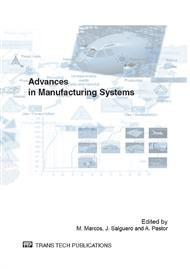[1]
W. Abdul-kader and A. Gharbi: Int. J. of Prod. Res. Vol. 40(18) (2002), pp.4815-4834.
Google Scholar
[2]
J.E. Ares: Estructura Jerárquica de Metodologías para la Implantación y Gestión de Sistemas de Fabricación Flexible (PhD Thesis, Universidad de Santiago de Compostela 1986).
Google Scholar
[3]
A. Villa, G. Fiorio and E. Ares: Production Planning and Control in Multi-Stage Multi-Product Systems, Edited by Andrew Kusiak, Published by Elsevier Science Publishers 1987, p.247.
Google Scholar
[4]
A. Villa, J. E. Ares and S. Rossetto: IMHE 1998, p.70.
Google Scholar
[5]
J.E. Ares, G. Peláez and R. Gómez, in: Modelo Dinamico para la Evaluacion de la Eficiencia de Estrategias de Produccion en Ambiente CIM, Anales de Ingeniería Mecánica (1990).
Google Scholar
[6]
J.E. Ares, J.A. Pérez and G. Peláez, in: Diseño de Células en el Lay-Out de un Taller y Análisis del Flujo Multi-Etapa/Multi-Producto en un Entorno CIM, X Congreso Nacional de Ingeniería Mecánica (1992).
DOI: 10.5944/bicim2022.095
Google Scholar
[7]
M. Amin and T. Altiok: Int. J. of Prod. Res. Vol. 35 (1) (1997), pp.201-223.
Google Scholar
[8]
Z. K. Weng: Eur. J. of Oper. Res. Vol. 109 (1998), pp.587-598.
Google Scholar
[9]
G. Peláez: Arquitectura y Modelo integral de un Sistema de Fabricación multietapa/multiproducto (PhD Thesis, Universidade de Vigo 1999).
Google Scholar
[10]
M. Al-Tahat, A. Liverani and F. Persiani, in: Computer Supported Design of Flexible Kanban System For a Multi-Stage Multi-Product Manufacturing Lines, First International Industrial Engineering Conference, Amman-Jordan (2001).
Google Scholar
[11]
Z. Zhang: Analysis and design of manufacturing systems with multiple-loop structures (PhD Thesis, Massachusetts Institute of Technology 2006).
Google Scholar
[12]
A. Resano: Análisis Funcional y Optimización de la Distribuición en Planta de una Línea de Ensamblaje de Automóviles (PhD Thesis, Universidad Pública de Navarra 2007).
Google Scholar
[13]
G. Ma and Y. Wang, in: Simulation and Improvement of Multi-product Multi-stage Processing System Based Witness, Industrial Engineering and Engineering Management, IE&EM`09, 16th International Conference on 21-23, (2009).
DOI: 10.1109/icieem.2009.5344298
Google Scholar
[14]
N. Li, L. Zheng and Q.L. Li: Comp. & Oper. Res. Vol. 36 (2009), pp.119-134.
Google Scholar
[15]
A. Villa and J. E. Ares, in: A methodology to analyze workshop lines by discrete event dynamic models, IX International Conference on Production Research, Editor: Anil Mital, pp.2072-2078, Vol. I, Ohio (1987).
Google Scholar
[16]
M. Loaiza: Diseño y simulación de un criptosistema caótico para comunicaciones seguras (Universidad de las Américas Puebla 2006).
Google Scholar
[17]
H.E. Lomelí: Sistemas Dinámicos (Departamento Académico de Matemáticas, Instituto Tecnológico Autónomo do México 2005).
Google Scholar
[18]
J.E. Villate: Introdução aos sistemas dinâmicos: uma abordagem prática com Máxima (Faculdade de Engenharia da Universidade do Porto, 2006).
DOI: 10.24840/978-972-99396-0-8
Google Scholar
[19]
R. Lázaro and C.J. Luis: Int. J. of Prod. Res. Vol. 46 (17), pp.4803-4825.
Google Scholar
[20]
A. Resano, C. Lázaro and C.J. Luis: Rob. and Comp. Int. Manuf. Vol. 25 (2) (2009).
Google Scholar
[21]
L. Pinto, E. Ares, G. C Peláez, J. Diéguez and B. Tjahjono: Int. J. of Adv. Manuf. Tech. (2011).
Google Scholar
[22]
L. Pinto, E. Ares, G. Peláez, M. Marcos and M. Araújo, in: Analysis of the influence of the production sequence in an automobile assembly line, modeled as a network of closed-loops, Proceedings of 4th Manufacturing Engineering Society International Conference, Cadiz (Spain), September 21-23, (2011).
DOI: 10.1063/1.4707615
Google Scholar
[23]
L. Pinto, E. Ares, G. Peláez and J. Diéguez, in: A Methodology for Decision-Making in the Performance Evaluation of Multiphase Multiproduct Production Lines", in Proceedings of 4th Manufacturing Engineering Society International Conference, Cadiz (Spain), September 21-23, (2011).
Google Scholar


